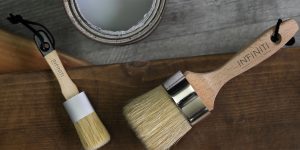What is better to use depends on what type of paint you use and how much work you want. There are pros and cons to both methods.
The use of a brush or roller for trim painting is related to the size of the area that you need to paint. Because using a brush involves more work than using a roller, it is not suitable if you need to paint large areas. Thus, when you need to paint it small, you can use a brush rather than a roller.
However, it will be easier for most projects to use a roller, and people use brushes only when painting small areas that are difficult to get to with a roller.
Why do people prefer roller?
Let’s go through the details of why it is more suitable to use a roller than a brush to paint the trim.
The roller is more suitable for painting smooth surfaces like door and window panels. Roller spreads paint evenly on the trim’s surface, fast and easy to use. When using the brush, you tend to get heavy strokes leaving visible lines in the paint, which are sometimes messy to clean up. Using roller gives an even and neat coating.
Using a roller gives clean lines over the trim’s surface with little or no edges visible at all. It makes the roller more suitable than a brush if you plan to paint the trim.
When painting trim, make sure you use a quality roller cover because cheaper ones tend to leave lint everywhere. You can even use roller covers that are made especially for walls because they are designed not to drip paint on the surface being painted or the floor, etc. Also, make sure you don’t overload your roller with too much paint, as it will start dripping.

When is it better to use a brush for trim painting?
A paint brushes for trim is an excellent option for painting trims that you can’t easily reach with a roller. It’s also a better tool when you want to paint the edges of the trim separately from the flat surface, such as in the case of chair rail or wainscoting.
When you use a brush, you cover small or irregularly shaped areas. It is useful when high-relief trims and moldings around the room, where the roller cannot reach. This technique gives you flexibility in terms of control over the process and allows for applying different paint styles (for instance, making the surface rough or smooth).
So what are the differences between a painting roller and a brush?
- Roller painting can be done faster than using a brush, especially for large surfaces. However, the roller cannot get into certain corners or hard-to-reach areas.
- With a brush, you have more control over the paint as it is applied to the surface. You can achieve an even finish, but this requires careful work and patience.
- For small, detailed work such as wooden trim or the edges of ceilings and door frames, a brush is probably your best bet. A roller can leave messy strokes along with these areas, but a good brush will lay down just the right amount of paint without leaving ridges or smears.
- When using a roller, you will lose much more paint than when using a brush. What this means is that if you’re painting a big wall, you’ll probably need to buy much more paint.














